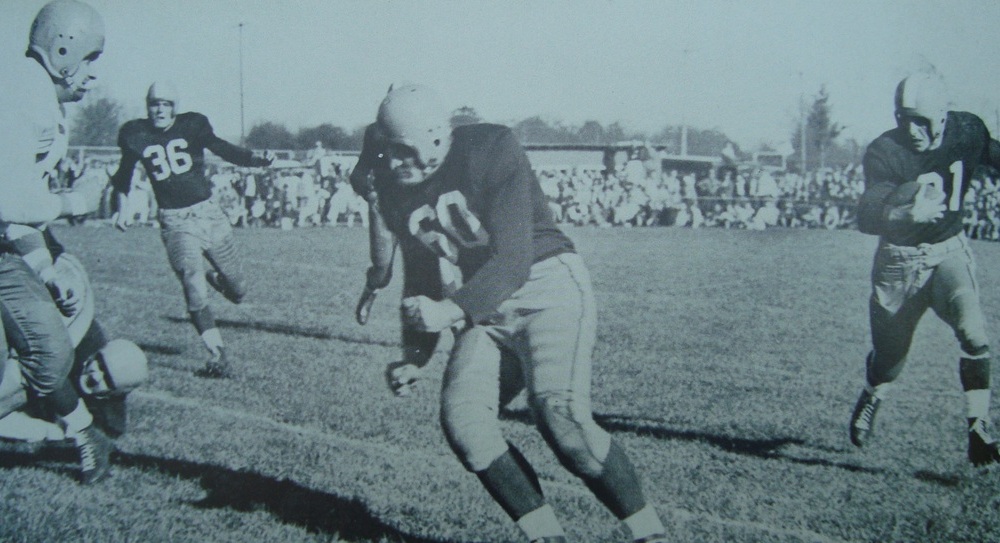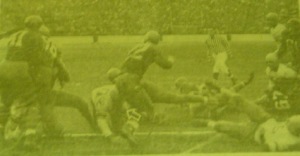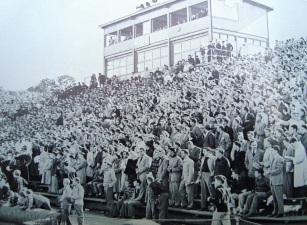
Flashback Friday: We Had a Football Team?
It’s that time of the week again and this week we are going way back into Bonaventure sports history. It all began in the late 1890’s when we were still just St. Bonaventure College. The first game on record was Thanksgiving Day, 1892. The competition was just intramural and no actual intercollegiate games were noted until 1903.
The team began to open some eyes in their intercollegiate competition. In 1906, the Brown and White went undefeated and did not give up a first down. In 1909, the team was undefeated yet again and were not scored on by any opponent. Impressive stats to say the least and not too long after, the Brown and White were playing in their first intercollegiate football season.
In 1915, James “Shine” McLaughlin became the head coach after proving himself with a brilliant career in athletics at Colgate. It was not any easy job for McLaughlin. The program was just beginning and it was tough to convince recruits to join the young team. He did well and helped the program grow, but his record did not portray all the hard work he did. He finished with a record of 13-22-6 in his seven years of coaching for an overall win percentage of .371, the lowest of any coach at St. Bonaventure.
The next three coaches that took over for the Brown and White, Alfred Carmot (1922-23), Glen Carberry (1924-25), and Fred Ostergren (1926-29), were all crucial to the progression of the program. Although none of the three had a winning record at the end of their tenure, they continued to build the football program at St. Bonaventure and raise the bar to new heights.
Up until 1928, all of the games were played on campus, but that would change as 10,000 seat Bradner Stadium was built in Olean. The first game was held there on September 17 of that year, which saw the Brown and White take down Niagara, 25-8.
In 1930, former assistant coach Carroll “Mike” Reilly was named the head coach after Ostergren’s departure. Reilly coached the team for 13 seasons and was one of the most loved and respected coaches in Bonaventure history. He was the first coach to post at least a .500 career win percentage, as he finished his career 44-44-7. It was not strange for the football coach to also coach basketball, as the past three had done it, but Reilly was a bit more involved to say the least. In his time at Bonaventure, Reilly coached football, basketball, and baseball. On top of that, he was also the athletic director. The team posted winning records in 1931, 1932, 1933, and 1935. In 1935, the “Dream Backfield” of Clem Faust, John West, John Labas, and “Whitey” Painton led the Brown and White to a 6-2-1 record, their best record since 1915. After that season, halfback Clem Faust was named a Little All-American, the first Bona player to receive national recognition. After coach Reilly’s passing, the school named the athletic arena after him, so we can now remember him when we are screaming like crazy at the next basketball game.
The team did not play between 1943 and 1945 because of World War II, but the first season after the war was one to remember.
After the war, enrollment increased significantly and there was a push for Bonaventure to become a big-time football program. To begin that journey, Bonaventure signed coach Hugh Devore, a former All-American at Notre Dame and coach at Providence College. Along with the exciting signing, former mayor Fred Forness donated $100,000 (equivalent to about $1.3 million in today’s economy) to build a new stadium on campus. Forness Stadium was built on the campus of St. Bonaventure and because of time constraints, it was not able to be substantially bigger than Bradner Stadium, like they had wanted.

Bonaventure scores their first touchdown against Canisius in their 1946 match-up (Photo from SBU Archives)
Bonaventure opened the 1946 campaign with a home game against Youngstown on September 28. In the first game at Forness Stadium, the Brown Indians (Yes, that was our old name) came up short, as they fell 20-14. This loss, however, would not be a true indication of what was to come. The Brown and White then won two straight, defeating Scranton (33-7) and Niagara (29-7). To decide the Little Three Championship, Bonaventure would take on Canisius in Buffalo. Over 35,000 people packed the stands to see these two battle for the Little Three bragging rights. Noted as one of the most iconic games in school history, the Brown Indians took down Canisius 13-0. Bonaveture won their last three games over St. Vincent, Bowling Green, and U.S. Merchant Marine (two of which were shutouts) and for the first time in school history, were selected to play in a bowl game. Coach Devore and the Brown Indians would head to Lexington, Kentucky to take on the Muhlenberg Mules in the Tobacco Bowl.
The Brown and White fell behind early, as they trailed 13-6 after the first quarter. The first Bona touchdown was punched in by Phil Colella, after Leo Haggerty broke away on a 45 yard run to Muhlenberg’s four yard line. It was a back and forth offensive battle, as both teams gained well over 300 yards of offense and the game headed to the fourth quarter tied at 19. In the fourth, Muhlenberg scored first on a 94 yard drive which was capped off by a Carminello Sbordone rushing touchdown, which gave the Mules a 26-19 lead. Bonaventure answered when David Curtin found Frank Lovoulo for a 38 yard touchdown, their second connection of the game. The ensuing place kick by Ted Mezejewski was no good, so the Brown Indians trailed 26-25. Bonaventure had one last drive with a chance to win the game. The Brown and White marched the ball all the way to the Muhlenberg five yard line, but Curtin was intercepted by George Bibighaus to seal the victory for the Mules.
Financing the team was beginning to be an issue, as the school searched for options to save the program. Sensing that this was the case, Devore resigned in 1950 after four seasons, finishing with a 25-9-1 record (.735). Shortly after his resignation, Canisius discontinued their football team and following year, Niagara did the same, thus ending Little Three football.
The 1950 season was not all doom-and gloom. A Bonaventure player by the name of John “Jack” Butler capped off his amazing career in the Brown and White by setting the ECAC Pass-Receiving record in his senior season. After going undrafted and being picked up on the basis of a recommendation, Butler went on to have an amazing NFL career, as he spent nine seasons with Pittsburgh Steelers. In those nine seasons, the accolades he earned are numerous. He was a four time pro-bowler, a three time first team All-Pro selection, he was part of the NFL 1950’s Decade Team, and also the NFL 50th Anniversary All Time Team. Most important of all, in 2012, Butler was inducted into the Pro Football Hall of Fame. Butler passed away on May 11, 2013.
Football continued under coach Joe Bach in 1950-51 but in 1952, the board decided to end the football program after 60 years. Bach finished with a record of 12-6 in his two seasons at the helm.
The school also had a club football team that ran from 1968-1971.
This story has been the most fun and by far the most interesting one to research and write so I hope you enjoy reading it as much as I did writing it!
Go Bonnies!
Here are a few highlights from St. Bonaventure’s game versus Pittsburgh in 1950
